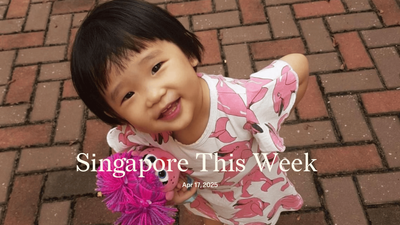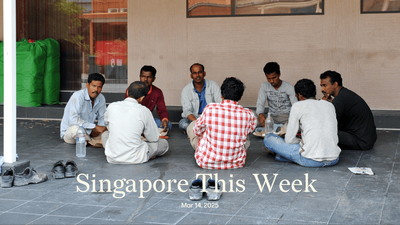Politics: Singapore’s support of Bush and the neocons
“It is clear to everyone, unless that person wears blinkers, that this is a war to remove the weapons of mass destruction from Saddam Hussein,” said Goh Chok Tong, Singapore’s then prime minister, a week after Operation Iraqi Freedom had begun, 20 years ago this week. What the Coalition of the Willing believed would be a quick war ultimately dragged on for years, with a gruesome human cost, including about 4,600 American military personnel and about 300,000 Iraqis. It sparked a civil war, bred new jihadists like ISIS, and, many have argued, laid the ground for the rise of Trump. It has been roundly condemned as illegal by numerous diplomats, scholars and politicians globally. Yet Singapore’s politicians, foreign policy experts, and mainstream media have never publicly reassessed our decision to support the US’s invasion and ultimately send almost 1,000 Singaporean soldiers to Iraq. Did Singapore, as a small state in a post-9/11 world, really have no choice but to support the US? In Goh’s bumper two-volume memoirs, he indulged in reams and reams of talk about a midnight golf game in 2000 with Bill Clinton in Brunei, but not once mentioned his decision to support Clinton’s successor in Iraq. In this week’s essay, Jom looks back at the invasion whose consequences we still live with.
Society: Death row lawyer in the dock
Human rights lawyer Ravi Madasamy (aka M Ravi) has said that he has “no regrets” about his career, after the Court of Three Judges (C3J) handed him a five-year suspension, the maximum sanction for lawyers’ misconduct in Singapore. “I chose to dedicate my 20 years to the cause of human rights and access to justice…at huge personal cost,” Ravi wrote on Instagram. He’s paid tens of thousands in punitive cost orders; faced contempt of court charges; and been barred from practising law several times. Among other incidents, in 2018 he was sentenced to an 18-month mandatory treatment order for assaulting fellow lawyer Jeannette Chong-Aruldoss. (Ravi, who was diagnosed with bipolar disorder in 2006, was given the order in lieu of jail time.) Ravi’s latest transgression? That he had made “grievous allegations” against Singapore’s criminal justice system. In 2020, having successfully reversed Malaysian Gobi Avedian’s death sentence, Ravi had accused the Attorney-General et al of “abusing their position and powers to take unfair advantage” of Gobi, and misleading the court resulting in his client being wrongly sentenced to death. In its judgement, the C3J also ruled that Ravi’s misconduct exhibits “a fundamental lack of respect and a blatant disregard” for key legal institutions. And that solicitors can’t be allowed to “recklessly and baselessly undermine” the pillars of the legal system. Human Rights Watch Asia and Malaysian rights group Lawyers for Liberty have criticised the decision. Such punitive measures, activists say, may obstruct prisoners’ access to “justice and effective remedies”, and their “right to life”. Ravi has made a name for himself taking on eleventh-hour appeals to defend death row inmates. Even his critics admire his dedication and resolve in championing seemingly hopeless cases. With Ravi unable to practise, more prisoners may have to represent themselves in their appeals to escape the noose.
Society: The kids aren’t alright
When recess time and orientation camps move to Zoom, it’s difficult not to feel isolated. There’s been much evidence globally of the pandemic’s harmful impact on learning and teenage life generally, and now we have data for Singapore. Some 37 percent of 15- to 19-year-olds surveyed, who would have been in their early- to mid-teens when the pandemic hit three years ago, reported a decrease in the ability to manage their mental health (compared to 28 percent in the overall population). They also felt less able to pursue their interests and hobbies, and indicated poorer friendships compared to pre-pandemic days. The Ministry of Communications and Information (MCI) commissioned the survey of 1,052 Singaporeans on the impact of the pandemic on different aspects of their life, such as: relationships with family and neighbours, mental and physical health and work-life balance. Meanwhile, caregivers with multiple dependants are almost twice as likely to experience a “poor” or “very poor” quality of life compared to the general population. Those who look after seniors or children are an “invisible workforce” susceptible to caregiver fatigue or burnout, where they may experience anxiety, depression and exhaustion as a result of what is often an around-the-clock job. MCI’s findings align with global trends, where caregivers all over the world faced added pressure and challenges during the pandemic. Given that married Singaporean women typically shoulder more household responsibilities than men, especially when it comes to child-related care, it’s likely that women were disproportionately affected. Still, 72 percent of all respondents said that their overall quality of life was the same or better now than before the pandemic hit. MCI and the mainstream media have cheered this finding, though it’s as important to remember the vulnerable among us.
Arts: One peck too many
This Sunday marks the fourth and (presumed) final print issue of Mynah Magazine, a cherished Singaporean long-form publication, and spiritual ancestor of Jom’s. In 2016-17, perhaps in response to the surfeit of clickbait content that dominated Singapore’s alternative media scene, three publications were founded to offer readers a deeper, more contemplative form of long-form journalism: New Naratif, Rice Media and Mynah. The similarities end there. New Naratif and Rice are online publications that were founded by established journalists, commentators or professionals with decent financial backing. Mynah is an annual (or sometimes biennial) print publication bootstrapped by then college undergraduates, led by Ruby Thiagarajan, its editor-in-chief. The magazine’s reputation has been growing over the years, and Issue #3, which Jom used as a reference for our own background research into print, is indeed impressive. We’re looking forward to seeing Issue #4 this Sunday. But why, on this upward trajectory, is Thiagarajan stepping down, leading to the magazine’s closure? In its announcement, Mynah said that it had “nothing to do with personal or creative differences within the team.” The speculation online is that Thiagarajan, a government scholar who now works at the Institute of Policy Studies (IPS), may have been asked to give up her side gig. Though not overtly critical of the government, Mynah has not shied away from broaching politically sensitive issues, for example the exploitation of migrant workers. (Last year Jom wrote about a seemingly analogous case of censorship, involving the T42 podcast.) Join Mynah for one last bash this Sunday, 12-8pm, at Love Handle on Ann Siang Hill. Tickets are free. Register through Eventbrite.
Arts: Hometown glory
March sees a trio of Singaporean authors being published overseas—novelists Balli Kaur Jaswal and Rachel Heng, and poet Tse Hao Guang. Jaswal’s Now You See Us, published by HarperCollins in the US and UK and chosen for Marie Claire’s Book Club, is a whodunit set in Singapore—three foreign domestic workers band together to solve the mystery of an employer’s death after a Filipina has been arrested for the murder. Jaswal’s earlier novel, Erotic Stories for Punjabi Widows, was featured in Reese Witherspoon’s massively popular book club and its film rights have been sold to Ridley Scott’s production house. Heng’s The Great Reclamation combines historical and speculative elements in a story of two friends who grow up during the tumultuous post-colonial (Japanese and British) period. It’s published by Riverhead Books, an imprint of Penguin group. Heng’s writing has also been published in The New Yorker and The New York Times. Tse’s new collection, The International Left-Hand Calligraphy Association, is published by Tinfish Books, a Hawaiian press specialising in experimental poetry of the Pacific. His previous collection, Deeds Of Light, was published by the now defunct Singaporean Math Paper Press. Do local writers need to publish abroad to truly “make it”? It’s hard to imagine international film studios optioning books published in Singapore, or that a purely local CV would get one the job of assistant professor of English at Wesleyan University, where Heng is currently employed. The three will be in conversation with novelist Daryl Qilin Yam tomorrow, March 25th, at Sing Lit Station as part of Sing Lit Shuttle, a weekend-long celebration of local literature. More information and tickets are available via Peatix.
History weekly by Faris Joraimi
I consider the National Library Board’s collection to be one of our city’s greatest treasures. Besides access to thousands of books, digital resources and powerful search tools (like NewspaperSG) that have transformed local history-writing in the last decade, it also provides every citizen a taxpayer-funded subscription to some of the world’s best magazines. The national library began life in 1845, when the Settlement’s leading British residents set up the Singapore Library. Its initial collection was a permanent loan from the Singapore Institution Library (the school library of what later became Raffles Institution). But membership was subscription-based: S$40/month for top shareholders and S$1/month for fourth-class members with limited borrowing privileges. It must have been a mark of status to be a library-goer in those days, no matter the tier. The city’s first public library was housed at the Singapore Institution (now Raffles City Shopping Centre), shifting locations and changing names at least two more times before becoming the National Library in 1960, at a much-loved, now-demolished tropical modernist building on Stamford Road. Its current main building on Victoria Street isn’t the prettiest to look at from the outside. But the 11th-floor Lee Kong Chian Reference Library, with its high ceiling and ample sunlight, definitely looks the part as a home for wonder, thought and contemplation: a cathedral of books. It’s also an important community space: school teens “study” with first loves, elderly uncles nap till it’s time for a Tiger. Who cares if only a few go there to read the books? George Bernard Shaw, playwright and socialist, wrote that the library’s work is measured not by numbers: “There are always two or three readers to keep the place in countenance. And if (to take actual cases) one of them is a Carlyle and another a Karl Marx, the results may range from the extension of the English Factory Code throughout the modern world, to a European world and half a dozen revolutions.”
Tech: The crypto winter gets colder
Following the numerous high-profile failures of cryptocurrency firms, such as Three Arrows Capital, Hodlnaut and Zipmex, it’s unsurprising to see Singaporean regulators reviewing their stance on cryptocurrencies. In response to a parliamentary question on the consultation to reduce risk of consumer harm from cryptocurrency trading, Tharman Shanmugaratnam, senior minister, said that the Monetary Authority of Singapore (MAS) aims to publish its response by the middle of this year. The consultation paper includes proposals on restricting consumer access to cryptocurrencies, business conduct, management of technology and cyber risks and market integrity. Singapore’s ambitions to become a global cryptocurrency led to investments by sovereign wealth fund Temasek in key players such as FTX and Animoca Brands. In addition, global leaders such as Binance, Huobi and Circle Internet Financial had set up offices in Singapore. Amid the heightened scrutiny and dampened mood, Binance later relocated to Dubai. With the crypto winter already setting in, it looks like it’ll get even colder once MAS releases its report.
Tech: Ohmygoodness
Amidst a global IPO downturn, property tech start-up Ohmyhome listed on the NASDAQ exchange in New York on Tuesday. Trading under the ticker symbol OMH, the company offered 3,775,000 ordinary shares at US$4 (S$5.35) apiece, raising US$11.2m (S$15.1m). The move comes as a surprise given the red flags raised by Tech in Asia over the company’s financials, particularly the inclusion of a payment for an uncompleted project to the company by its chairman, David Loh. Furthermore, Ohmyhome’s own accountants expressed “substantial doubt” over the IPO given the company’s negative cash flow of US$1.3m (S$1.7m) in 2021, with US$1.1m (S$1.5m) of working capital and US$0.9m (S$1.2m) of cash remaining on its balance sheet. Ohmyhome’s valuation of under US$90m (S$120.4m) pales in comparison to that of fellow Singaporean property tech start-up PropertyGuru, which is listed on the New York Stock Exchange and has a market capitalisation of well over US$700m (S$936.3m). Brave, naive or suspicious? The market is watching closely.
If you enjoy Jom’s work, do get a paid subscription today to support independent journalism in Singapore.







